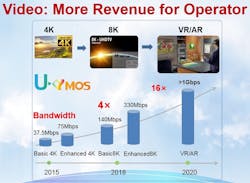An intelligent world is emerging, and the need for ultra-broadband networks to accelerate this new world is growing at an unprecedented pace. There are currently 350 deployed gigabit network projects across the globe, and it is becoming increasingly accepted that gigabit broadband will be the cornerstone of the intelligent world.
Gigabit broadband networks as well as relevant services and applications will provide many opportunities in areas such as healthcare, education, employment, transportation, agriculture, trade, and government services, and will greatly enhance the growth of the global economy. In the 21st century, gigabit broadband networks have already influenced our lives in many ways and are fast becoming an indispensable infrastructure like roads, railways, water supply, and electricity supply networks.
Gigabit broadband networks have accelerated the development of new experiences and created business opportunities such as Alibaba Group's "Buy+" virtual reality (VR) online shopping platform, Mobike's app-driven bike-sharing services, Airbnb's hotel sharing network, and Amazon and JD.com's revolutionary online shopping services. Analysts now predict that the number of gigabit subscribers could hit upwards of 100 million by 2020.
This trend is also ushering in a new era of "Gigaband Cities" that use next-generation PON technologies to deliver gigabit coverage for the cities' communities. For example, Shenzhen has become the first city in China to deliver gigabit broadband connectivity to 900,000 homes. Services will be available for residential users, government agencies, and enterprises, and will be capable of enabling advanced services including 4K video and VR film streaming, Gigaband hotels, and passive optical LANs (see Figure 1). Based on the experience with the rollout, this first project in China is expected to define the standards for a Gigaband City, paving the way for future deployments.
Gigaband Cities will strive to keep pace with consumer demand for new internet applications such as 4K/8K video, VR and augmented reality (AR), Gigaband campuses, and smart homes. Gigabit broadband networks will also foster digital innovation within vertical industries such as healthcare, financial services, transportation, manufacturing, and more.
Government Approaches to National Broadband Projects
ICT and broadband infrastructure have become core economic competencies, critical for national competitiveness. At the same time, broadband has become a basic need for citizens, who cannot imagine their lives without a broadband network and applications.
As a result, governments across the globe have made national broadband programs an imperative to ensure high-speed internet is accessible and affordable to everyone. However, the development of broadband initiatives varies greatly around the world. In Asia-Pacific, for example, Japan, Republic of Korea, and Singapore are world leaders with a broadband penetration of 95%. However, in countries such as Myanmar, Bangladesh, and Cambodia, less than 5% of the population has access to broadband. In these countries, government and policy support is essential to accelerate infrastructure growth and increase external connectivity.
Governments in these countries and around the world play an instrumental role in advancing national broadband initiatives to improve services for citizens. They can lead infrastructure development by building alliances among different government departments and industry, as well as creating broadband-friendly industrial policies.
Governments can also improve infrastructure synergy and find ways to simplify the process of obtaining rights of way. They can ensure new buildings and renovation projects include fiber connections, produce explicit standards for compensation for eminent domains, and start universal service funds. Governments can also legislate comprehensive frameworks for ICT; expand international fiber links; loosen restrictions on carriers, investors, and infrastructure builders; release more spectrum; and make more efficient use of spectrum resources.
Gigabit broadband can provide many benefits to both businesses and residents. For businesses, it helps them to innovate and expand into different markets. It also has the potential to increase efficiency and drive down costs. These business gains will help accelerate economic growth and prosperity for the country.
For residents, they will have improved access to online shopping, banking, healthcare, and public services. They also will connect seamlessly with family and friends and enjoy new levels of home entertainment. Providing fast and effective gigabit broadband will drive social empowerment, helping citizens thrive in their work and home lives.
Telecom Operator Approaches to Accelerate Gigabit Broadband
To remain competitive telecom operators need to take advantage of new and advanced technologies such as next-generation PON over fiber, G.fast over copper, and DOCSIS 3.1 over coax that enable greater bandwidth, agility, and scalability to meet the demands of the gigabit era. However, according to Ovum, operators face many network transformation challenges, such as choosing the best technology strategy and understanding its impact on future upgrades, identifying new revenue opportunities, and meeting rollout targets and network optimization goals.
With the development of cloud computing, the internet of things (IoT), and 4K video industry chains, the fixed broadband industry has entered a new round of rapid development.
Globally, fixed broadband has become a focal point for investment in the ICT industry. We now see demand for access devices for fiber to the building (FTTB), fiber to the cabinet (FTTC), fiber to the door (FTTD), fiber to the home (FTTH), and Distributed CCAP (D-CCAP) scenarios as well as matched outdoor cabinets, and ODN products for offering "one-stop" Gigaband access to customers (see Figure 2).
Video services are the most important business opportunity for telecom operators today. Many global telecom operators have a well-developed video strategy, which is designed to drive the growth of broadband services and increase the number of broadband customers and the average revenue per user (ARPU), instead of merely positioning video services as a value-added service.
Looking forward, the industry's digital transformation is another strategic opportunity for operators. Operators should rethink their positioning and business scope in the B2C, B2B, and IoT markets. As enterprise customers require integrated ICT services that can provide a Real-time, On-demand, All-online, DIY, and Social (ROADS) experience instead of just basic communications service, operators need to "cloudify," and transform themselves into cloud service providers. Only then will they be able to meet enterprise customers' ever-growing demand for digitalization.
Evaluating Gigabit Broadband Success
In terms of coverage, we can expect gigabit broadband networks will cover over 90% of households by 2020, making the ubiquitous ROADS experience possible. Operators will need to invest in broadband infrastructure to provide low latency, high bandwidth, and advanced customer experiences to all their customers.
Implementing a gigabit broadband strategy requires the joint efforts of ultra-broadband industry players and governments. Industry policies must change from encouraging competition to promoting investment, and municipal infrastructure can be opened to operators, helping operators reduce FTTH and deployment difficulties (see Figure 3). For example, China implements fiber-from-the-home for new buildings to facilitate FTTH. Operators also need to formulate network development strategies to support a gradual evolution and build data center-based simple and agile ultra-broadband networks. Operators should increase investment in innovative gigabit applications to realize the value of gigabit networks and form a healthy ultra-broadband industry circle.
Jack Zhu is vice president, Access Network Product Line, at Huawei.




